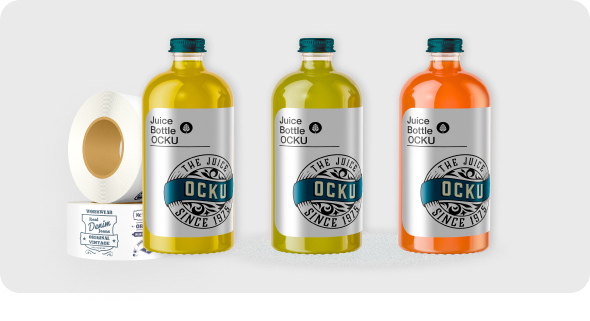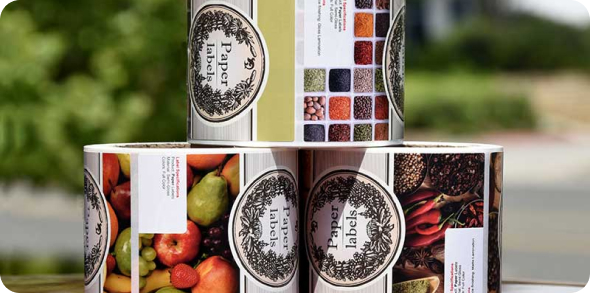Variable data printing (VDP) enables the mass production of personalized labels without slowing down the printing process. As brands are constantly looking for new ways to enhance customer engagement and boost conversions, implementing personalized marketing strategies is a great way to achieve this. Studies show that 76% of consumers are more likely to purchase from brands that use personalization techniques in marketing efforts. Variable data printing enables brands to create personalized experiences for their customers, leading to increased purchases.
Whether you’re in the beverage, pharmaceutical, retail, or cosmetics industry, using personalized printing techniques can help your products stand out on the shelf while increasing customer interaction. In this guide, we’ll explore how variable data printing works, its benefits, and best practices for implementing it into your business strategy.
What is Variable Data Printing?
Variable data printing (VDP) is a digital printing technique that allows customized text, images, barcodes, and designs to be changed dynamically within a single print run. Unlike traditional printing methods, where all copies are identical, VDP enables brands to tailor each print to specific customer preferences.
To execute the process smoothly, all text and image variations must be finalized beforehand. This information is stored in a database and spreadsheet, which are then linked to the label printing software. The digital press automatically pulls the necessary text and graphics from the database, printing each variation in a structured sequence.
For example, a beverage company might print unique QR codes on each bottle to provide customers with product details, promotions, or loyalty program incentives. Similarly, e-commerce businesses can use personalized labels to print customer names, order details, or location-specific messaging.
Types of Variable Data Printing Options
Variable data printing allows for the customization of different types of information on product labels, enhancing efficiency and compliance.
- Barcodes: Assigning unique barcodes to each product improves inventory tracking and streamlines supply chain operations.
- Serial Numbers: Implementing serial numbers with VDP simplifies product tracking, aiding in warranty management and theft prevention.
- Batch and Lot Numbers: Distinct batch and lot numbers enhance traceability, ensuring quick responses to recalls and maintaining quality control.
- Manufacturing and Expiration Dates: Dynamically printing these dates ensures compliance with food safety regulations and provides accurate information to consumers.
- Regional Pricing: Customizing prices based on location helps businesses adhere to regional pricing regulations and market demands.
- Promotional Codes: Personalized promo codes enable brands to track marketing performance, boost engagement, and offer targeted discounts.
- Product Variations: VDP simplifies labeling for different product versions, reducing errors and maintaining accuracy.
- Regulatory Compliance: Printing essential regulatory details ensures that products meet industry standards and minimize the risk of non-compliance.
How Does Variable Data Printing Work?
Variable data printing relies on a combination of digital printing technology and database-driven customization. Here’s how the process works:
- Data Collection & Segmentation – Customer information, product details, or unique elements (like serial numbers) are gathered into a database.
- Design Integration – Using specialized software, the collected data is merged with the label design template.
- Automated Printing – The digital press reads the database and prints unique labels without interrupting production.
- Final Processing & Distribution – Once printed, the personalized labels are applied to their respective products.
Benefits of Variable Data Printing
1. Increased Customer Engagement
With personalized printing, brands can create a stronger connection with their audience. Customized labels that include customer names, personalized messages, or interactive QR codes encourage higher engagement and brand loyalty. This tailored approach makes products feel more exclusive and relevant to individual customers.
2. Enhanced Marketing Opportunities
Variable Data Printing allows companies to run highly targeted marketing campaigns. For example, Coca-Cola’s “Share a Coke” campaign, which featured customer names on bottles, increased sales by over 7% globally. Such campaigns show how personalized packaging can drive customer interest and affect consumers’ buying decisions.
3. Efficient and Cost-Effective
Unlike traditional printing methods that require separate printing plates for each design, variable data printing allows for seamless customization without additional costs. This makes it ideal for small to large-scale print runs.
4. Better Inventory Management
For businesses handling multiple SKUs, VDP reduces storage costs by allowing on-demand printing instead of stockpiling pre-printed labels. This flexibility is particularly beneficial for industries such as food & beverage and healthcare where regulations and product variations frequently change.
5. Improved Security and Traceability
Industries such as pharmaceuticals and cannabis benefit from VDP by incorporating serialized barcodes, QR codes, and RFID tracking to ensure product authenticity and prevent counterfeiting.
Applications of Variable Data Printing in Different Industries
1. Beverage & Food Packaging
- Custom QR codes linking to promotions
- Personalized messages on bottles
- Nutritional labeling updates for regional compliance
2. Pharmaceuticals & Healthcare
- Unique serialization codes for tracking
- Patient-specific medicine labels
- Multilingual product information labels
3. E-commerce & Retail
- Personalized packaging for direct-to-consumer brands
- Custom labels for subscription boxes
- Location-based marketing on product labels
4. Wine, Spirits & Craft Beverages
- Limited-edition labels for seasonal releases
- Augmented reality labels for immersive storytelling
- QR codes linking to online brand experiences
Best Practices for Implementing Variable Data Printing
1. Use High-Quality Data
Clean, up-to-date customer data helps create meaningful and precise personalization, increasing the effectiveness of your campaign. Ensure that the data driving your personalized labels is accurate and well-segmented. Poor data quality can lead to misprinted labels or irrelevant customization.
Utilize data validation tools and regularly update your database to avoid errors. Additionally, segment your audience based on demographics, purchase history, or preferences to deliver more relevant and impactful messaging.
2. Optimize Your Design for Personalization
Design labels with flexible layouts that accommodate variable text and imagery without compromising aesthetics. Using bold typography and clear fonts ensures readability.
Incorporate dynamic design elements that seamlessly adjust to different data inputs, maintaining a polished and professional look. Avoid overcrowding the layout with excessive text or images, ensuring a balanced composition. Testing various design variations beforehand can help identify the most effective format for personalization.
3. Leverage QR Codes & Smart Labels
QR codes, RFID tags, and NFC-enabled labels can bridge the gap between physical packaging and digital experiences. These can direct customers to product details, loyalty programs, or augmented reality experiences.
Incorporating these smart labels enhances customer engagement by providing instant access to valuable content with a simple scan. Additionally, they enable brands to track interactions, gather consumer insights, and refine marketing strategies based on real-time data.
4. Test and Iterate
Before rolling out a full campaign, test your VDP labels on a sample audience to gather insights and refine your approach. Conducting small-scale tests helps identify potential design or data issues before full production.
Gather feedback from users to ensure readability, functionality, and overall effectiveness. Continuously analyze results and make necessary adjustments to optimize performance and maximize engagement.
Trends in Variable Data Printing for 2025
AI-Driven Personalization
Machine learning algorithms will further refine customized packaging based on customer behavior and demographics. AI will enable real-time adjustments, ensuring that each printed piece is highly relevant to the target audience. Brands can leverage predictive analytics to anticipate customer preferences and create more impactful, data-driven designs. This level of automation will streamline the printing process while enhancing personalization at scale.
Sustainability in VDP
Eco-friendly inks, biodegradable materials, and low-waste printing techniques will become the standard. Advancements in digital printing will minimize excess material usage, while recyclable and compostable packaging options will gain popularity. These innovations will help businesses align with growing consumer demand for environmentally responsible practices.
Blockchain-Integrated Packaging
Secure, tamper-proof labels powered by blockchain technology will be used for tracking and authentication. This innovation will enhance supply chain transparency, allowing consumers to verify product authenticity with a simple scan. As trust and traceability become key priorities, more brands will adopt this technology to protect both their products and their customers.
As brands move towards hyper-personalization, variable data printing is becoming a game-changer in the packaging industry. With advancements in AI, blockchain technology, and sustainable materials, the future of variable data printing is evolving rapidly. Brands that embrace these innovations will not only enhance customer experiences but also build stronger trust and loyalty. By investing in cutting-edge VDP solutions, businesses can create packaging that is both dynamic and secure, setting new standards in the industry.
If you’re looking for high-quality variable data printing solutions, our team of experts is here to help you implement customized labeling for your products. Let’s work together to elevate your brand with precision, personalization, and innovation.



